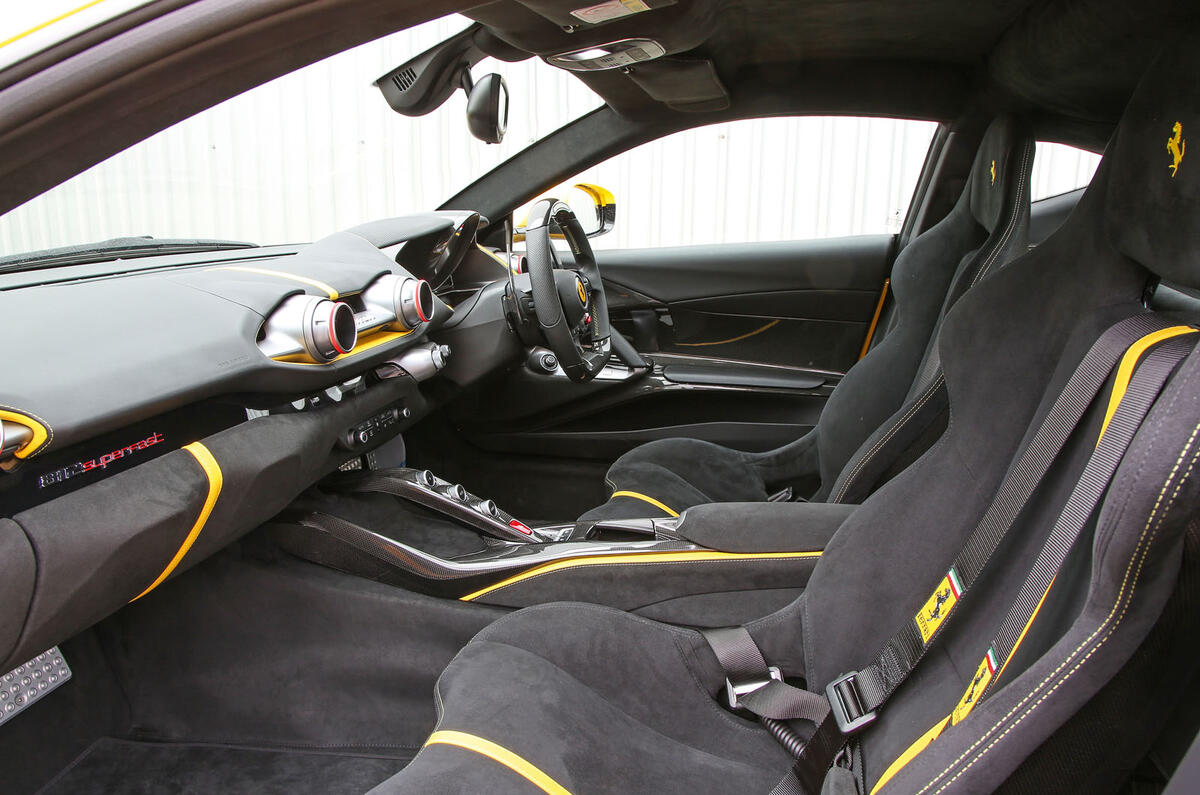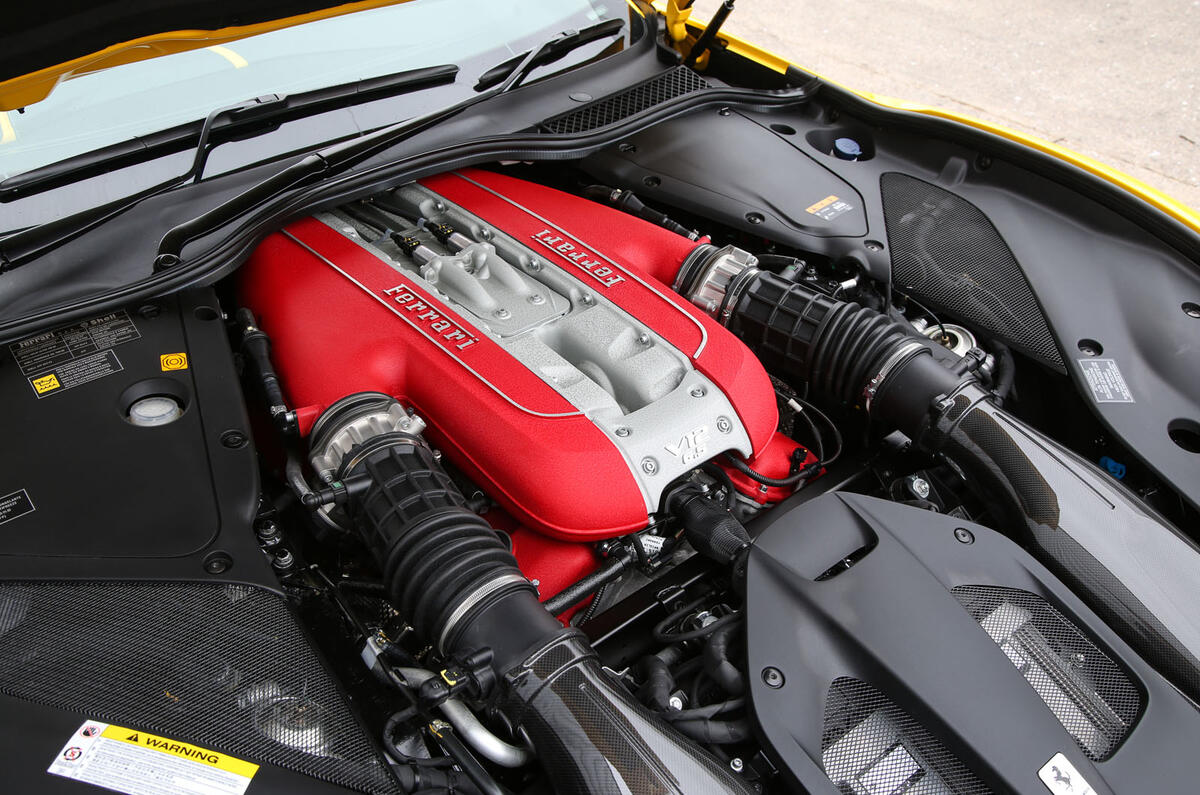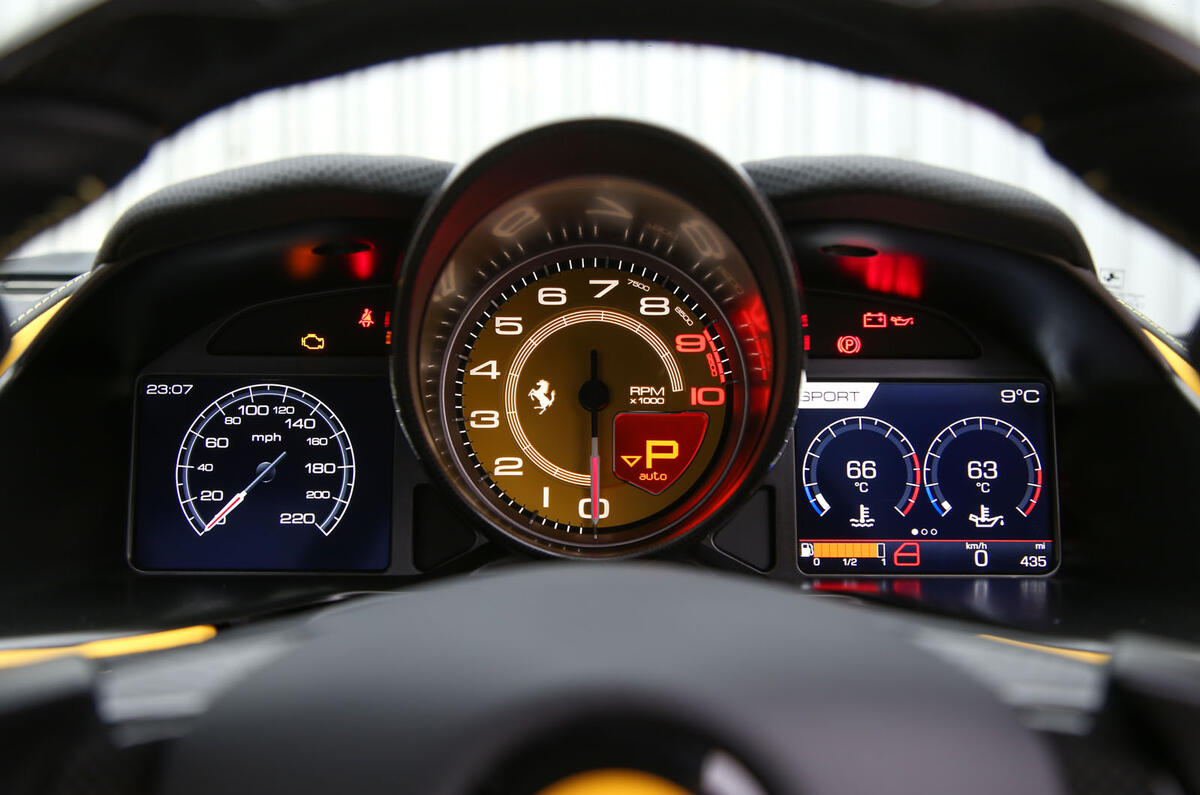Ferrari 812 superfast

While the observant will have noticed that it hasn’t actually used it on the official model name of the new 812 Superfast, it has used it on the car’s internal codename. The car’s immediate predecessor, the 2012 F12 Berlinetta, was simply known as ‘F152’ to anyone personally connected to its creation; the new 812 is ‘F152M’. Which tells you a lot about what’s underneath this car, how ‘new’ it really is and how close a relationship it has to the F12.

The Superfast is in essence a widely and significantly updated version of the F12. It brings quite a substantial power hike, as well as some transmission, suspension, aerodynamic and steering revisions, to the market for front-engined ‘Super GT’ coupés, which Ferrari so famously dominated and influenced through cars such as the 250 and 275, the 365 GTB/4 ‘Daytona’ and the 550 Maranello.

The power increase would thrust Maranello’s latest series production flagship through the ‘800’ horsepower threshold if only us Brits accounted for those horses in the same way in which they’re rounded up and numbered in mainland Europe.
Ferrari’s aim with all of this? To send the 812’s performance benchmarks soaring even higher than the F12 Berlinetta’s were relative to those of its rivals and to give it, in Ferrari’s own words, “the most riveting and rewarding driving experience possible”.
But what are the inevitable consequences and compromises to the car’s core abilities as a distance-covering, head-scrambling, two-seater grand tourer? Stand by to find out

The heavily modified ‘Tipo F140-GA’ 6496cc V12 has enough new internals that we might as well consider it an entirely different engine even to the F12’s 6262cc unit, although it can also trace roots back to the Ferrari Enzo’s 5998cc mill.
Having been ‘stroked’ to produce the necessary additional cubic capacity, the V12 also has a higher compression ratio than the F12’s engine, as well as a higher-pressure fuel injection system, a redesigned exhaust and the ingenious variable induction system of the F12tdf.
It revs all the way to 8900rpm and it produces 530lb ft at 7000rpm, but 80% of the torque is on tap from just 3500rpm. Aston Martin’s DBS Superleggera, which has yet to make it onto UK roads, won’t get within 70bhp of the 812 on peak power and that’s with the help of turbocharging.
Meanwhile, just like in the F12, the 812’s ‘front-mid’ layout means the entirety of the car’s engine block sits behind the car’s front axle line. A rear-mounted seven-speed twin-clutch transaxle gearbox (with intermediate ratios shortened by an average 6% versus the F12) contributes to a claimed weight distribution of 47:53; on our scales, it showed as 49:51.
The car’s steel coil suspension has been stiffened slightly compared with that of the F12, and its adaptive dampers retuned, while the car’s power finds its way to the road via a retuned electronically controlled ‘e-diff’ active differential.
The rolling chassis departs more notably from the template of the F12’s in two key areas: by the addition of the F12tdf’s ‘virtual short wheelbase’ four-wheel-steering system and by the switch from hydraulic to electromechanical power steering. The 812 also borrows its steering rack directly from the F12tdf, while its forged alloy wheels – now fully 10in wide on the front axle – are also the same size as those of the F12tdf.

he car’s already-busy steering wheel boss has had a light redesign and a couple of buttons added to it (for the voice-activated control system and telephone). And yet, because the controls you use most often on it (turn indicators, wipers, headlights) have been enlarged, they’ve become a touch easier to find without looking and without fumbling around for too much.
The wider dashboard looks a touch leaner and more sculpted and, unusually for what’s effectively a mid-life facelift, it features one less jet-exhaust-style air vent. Lower down, the volumes of the car’s extruded-style centre console have been reduced, and the bridge of carbonfibre on which the car’s transmission and hazard warning light controls are carried is slimmer and easier to reach beyond if you’ve put something in the slim cubby behind it.
Wider cabin storage space is fairly scant, but the car’s door pocket will just about accommodate a wallet, phone or water bottle. There is a usable cupholder too. For a while, you can certainly convince yourself that more thought than you might expect of Ferrari has been invested in good ergonomic layout and sensible ease-of-use in the 812

That is, at least, until the sun comes out and you realise that the ‘dayglow’ yellow contrast leather on the dashboard (it’s optional, mercifully) reflects in the windscreen to distracting extremes. Or until you try to set a destination into the navigation for the first time and, five minutes later, you’re still trying. Then again, perhaps a Ferrari needn’t be that easy to use.

Ferrari’s ‘infotelematic’ infotainment system has been updated for the 812, with a new control regime and new navigation mapping, as well as eight times more processing power than the F12’s system had. Presenting the system inside two 5.0in screens inside the instrument binnacle continues to impose limitations on usability, however.
Despite the revisions to Ferrari’s menus, we found the car’s mapping hard to orientate to our liking and to follow. Customers can delegate control of the audio system to the passenger by optioning Ferrari’s 8.8in passenger display (£3360), through which you can manage and shuffle audio sources.
Apple CarPlay is equally expensive (£2400) but, as a way of avoiding Ferrari’s own navigation system, it’s advisable to have it.
Also available is an evolved telemetry system derived from the one aboard the LaFerrari, and a highend audio system with 12 speakers and a 1280-watt amplifier. The car’s standard audio system quality is respectable if unspectacular.
For carrying space, the 812 is exactly as the F12 was: there’s a boot big enough for one large case or a couple of smaller holdalls, plus a good-sized shelf behind the seats with a couple of securing straps. This is, in short, probably every bit as practical a car as it needs to be to effectively serve a touring brief.

The 812’s 12-cylinder engine is utterly extraordinary in all the ways you hoped it would be: for its outright force, its pedal response and proportionality, its docility and good manners at low revs, and for the repertoire of virtuoso moans, growls, howls and wails it works its way through on the way to that near 9000rpm redline.
Only Porsche’s 4.0-litre flat six from the 911 GT3 and Lamborghini’s very finest V10s and V12s compare with it in any of the above respects and not in all of them, by any means. But it’s the apparently perfect linearity of the engine’s power delivery that stays with you.
This engine has no flat spot; it needs no notice period to give up its brilliant best. If you engage sixth gear below 30mph (as you surely won’t once you know how great the engine sounds at high revs), you can use full throttle straight away without any fear of the slightest bit of rough or uneven combustion. And then you just sit back and watch the revs and speed pile on so metronomically.
In sixth, it takes 3.7sec for the car to accelerate from 30mph to 50mph; which may not seem particularly impressive until you read that it takes just 3.6sec for it to go from 130mph to 150mph in the same gear. Every 20mph accelerative increment in between is dispatched within four-tenths of a second of the same time
 Dri
Dri

 Dri
Dri
The car’s gearbox works smoothly at low speeds and would be entirely untroubling to live with and, although it doesn’t creep when you lift off the brake pedal, it allows you to be as precise as you like when manoeuvring. Its paddles are column-mounted and they’re large, so they’re easy to find when you’re feeding the wheel.
The gearshifts they prompt show just enough hesitancy to feel marginally slower than those of, say, a Porsche 911 GT2 RS or a McLaren 720S, but without having driven either of the other two, you’d never recognise any kind of deficiency. All of which adds up to a powertrain that loves to be taken to task and extended into the stratosphere.
When it comes to cruising, which any kind of GT car ought to be well capable of, the engine settles down to a fairly unintrusive noise level. There’s always plenty of tyre roar flooding into the cabin – as you might well expect of a car that rolls on such wide wheels – but not enough in itself to put you off taking on longer trips.
Meanwhile, the car’s 92-litre fuel tank means that, although we recorded only 23.8mpg from the car as a touring economy test result, you could still put more than 450 miles between fills when you needed to.
Its steering is light, reactive and super-direct, its ride both skittish-feeling at times and sufficiently short on travel that you worry you might bottom-out on testing B-roads. And all in a car ready to oversteer in the blink of an eye, if you even think about encouraging it to do so. ‘A wild ride’ doesn’t really even begin to cover it.
The primary ride feels even firmer and more aggressive than the F12’s was – and considering that the F12 at times felt incompatible with any vaguely bumpy British road itself, that’s problematic to begin with. Even in Ferrari’s ‘bumpy road’ damping mode, the 812 gybes, oscillates and fidgets over surfaces that a Super GT ought to have the suppleness to cope with. Certain intrusions taken at speed make its suspension feel slightly wooden, and others under-damped, as it threatens to drag its underbelly through bigger compressions and over ridges.
Those wide front tyres, meanwhile, are particularly reactive to road camber, and prone to both bump steer and tramlining on really testing B-roads. There are times, even on smooth Tarmac, when the car can test your concentration by flirting with momentary oversteer as its outside rear tyre slips on a painted road marking, or by diving one way or the other as a patch of water disturbs its stability under braking.
All of these things are reasons that the 812 Superfast might not be first choice for an idyllic holiday drive to the Cote d’Azur. At times, the car will thrill you in ways that many mid-engined supercars couldn’t reproduce. Its sheer agility and handling balance is little short of incredible, but it would make you feel slightly restive and uneasy at the wheel even on the motorway and can be fatiguing over longer stints in a way unwelcome in a Super GT.
Track use obliges the 812’s tyres and brakes to engage in a Sisyphean struggle to marshal and contain the sheer potency of its 789bhp V12 engine. For a while they enjoy some success but, at least if you give that engine its head without much consideration for the consequences, ultimately both are left in a steaming, frazzled mess.
There is more than enough power to cue up an armful of oversteer in almost any gear and cornering situation. When a slide comes, it comes quickly but the sheer directness of the car’s steering means you can apply corrections with matching speed.
Driving the car with pace and precision requires discipline, although keeping Race mode activated maintains handling stability well, at a cost of some intrusiveness. Optional track-day tyres should be available later this year; our standard-fit Pirelli P Zeros began to overheat after
Right now, you won’t find many three-year-old examples of the F12 around for less than £200,000. And given how few 812s will be sold at prices under £300k following options, it’s unlikely you’ll find many of those around for what might be considered a bargain price after a similar time frame either.
If you plan on keeping your car for longer, you may be interested in the seven-year free servicing plan that Ferrari has been offering as standard on its cars since 2011. It covers the cost of scheduled servicing, spares and fluids, and is transferable to subsequent keepers. Meanwhile, the 812 comes with a four-year warranty, extendable to as many as 12 years at extra cost.
Few could say the company wasn’t doing its best to take the financial risk out of exotic car ownership, and the improvement it has seen in its residual values is likely testament to its success.
The company’s commitment to making the fastest, most powerful and most exciting options within the niches of the sports car market in which it competes has brought us some sensational driver’s cars in recent years, and has brought us another memorably visceral and rambunctious one in the new 812 Superfast.
The 812’s V12 engine is spellbinding and rules over its surprisingly plucky, playful chassis with an almost irresistibly despotic swagger. But the car’s inability to adopt a measured, stable, low-effort long-distance stride is a smear on its CV and evidence that perhaps Ferrari should guard against letting its ego get the better of it with every car that it makes.


Comments
Post a Comment